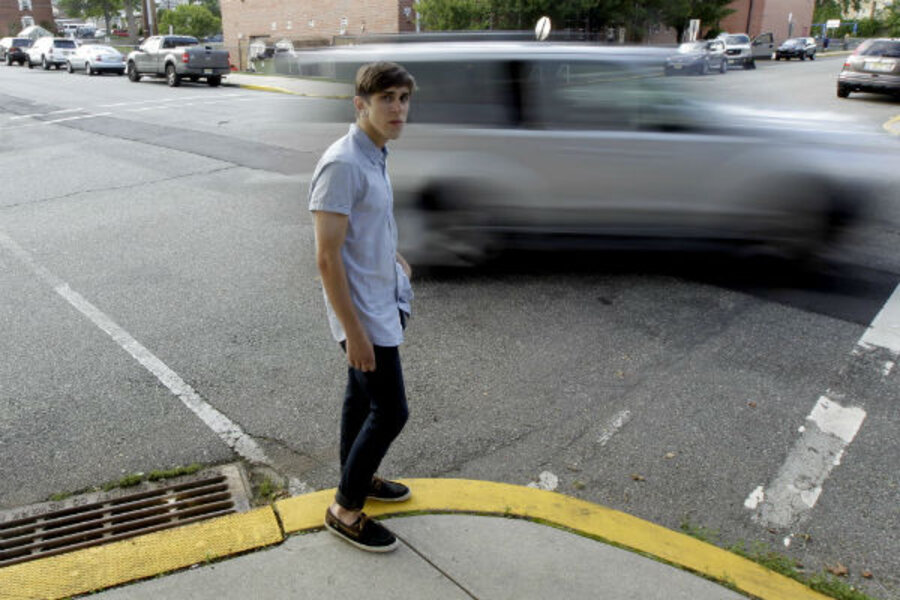Teen texting and driving: More than half admit to doing it
Loading...
| Atlanta
Think your teen would never text while driving? More than half of high school seniors admitted in a government survey that they've done just that.
It's the first time the question was asked in a teen poll on risky behavior, and the finding comes amid a renewed federal crackdown on distracted driving.
Texting and cellphone use behind the wheel is "a national epidemic," Transportation Secretary Ray LaHood said Thursday.
"We need to teach kids, who are the most vulnerable drivers, that texting and driving don't mix," LaHood said at a Washington news conference to announce pilot projects in Delaware and California to discourage distracted driving.
In the survey, about 58 percent of high school seniors said they had texted or e-mailed while driving during the previous month. About 43 percent of high school juniors acknowledged they did the same thing.
"I'm not surprised at all," said Vicki Rimasse, a New Jersey woman whose son caused a fender bender earlier this year after texting in traffic. She made him take a safe-driving class after the mishap.
"I felt like an idiot," said her 18-year-old son, Dylan Young. The episode taught him "to be a lot more cautious," although he conceded that he sometimes still texts behind the wheel.
The findings released Thursday are the first federal statistics on how common the dangerous habit is in teens. Distracted driving deaths are most common in teens, blamed for about 16 percent of teen motor vehicle deaths.
Focusing on a cellphone instead of the road leads to delayed reaction times, lane swerves and other lapses with sometimes fatal consequences, experts say.
Thirty-nine states ban texting for all age groups, and an additional five states outlaw it for novice teen drivers. And authorities are increasingly cracking down. In the last two weeks, teens in Missouri and Massachusetts have been sentenced to jail — one for a year — for fatal accidents involving texting.
For the survey, the Centers for Disease Control and Prevention last year questioned more than 15,000 public and private high school students across the country. Some earlier studies had suggested teen texting while driving was becoming common, though perhaps not quite so high.
Still, the numbers aren't really surprising, said Amanda Lenhart, a senior researcher at the Pew Research Center in Washington. She studies how teens use technology.
A typical teen sends and receives about 100 text messages a day, and it's the most common way many kids communicate with their peers.
"A lot of teens say 'Well, if the car's not moving and I'm at a stoplight or I'm stuck in traffic, that's OK,'" said Lenhart, who has done focus groups with teens on the topic.
Other teens acknowledge that it's not safe, but they think it is safer if they hold the phone up so they can see the road and text at the same time, she said.
The CDC survey didn't ask whether the texting or emailing was done while the vehicle was moving or stopped. The survey is conducted every two years, but this was the first time it asked about texting while driving.
Young's fender bender occurred one winter afternoon while he was in crawling traffic on his way to a guitar lesson. No one was hurt.
It's frustrating that the accident did not break him of the habit, Rimasse said.
She described her son as an articulate honors student in North Arlington who walks to school and spends little time in the SUV that they share.
But he is also part of a teen culture where virtually everyone texts while driving and thinks nothing bad will happen, she lamented.
"Nothing seems to stop them," his mother said. "It's ridiculous."
"Everybody just does it," Young said.
CDC officials said there was some good news in the survey:
— More teens are wearing seatbelts. Only 8 percent said they rarely or never wear seatbelts, down from 26 percent in 1991.
— Fewer teens said they drove drunk (8 percent vs. double that in the 1990s) or rode with a driver who had been drinking (24 percent, down from 40 percent).
Overall, teen deaths from motor vehicle crashes are down 44 percent in the last decade. About 3,100 teens died from traffic crashes in 2009, according to the most recent federal statistics.
___
Associated Press Writer Joan Lowy in Washington, D.C., contributed to this report.





